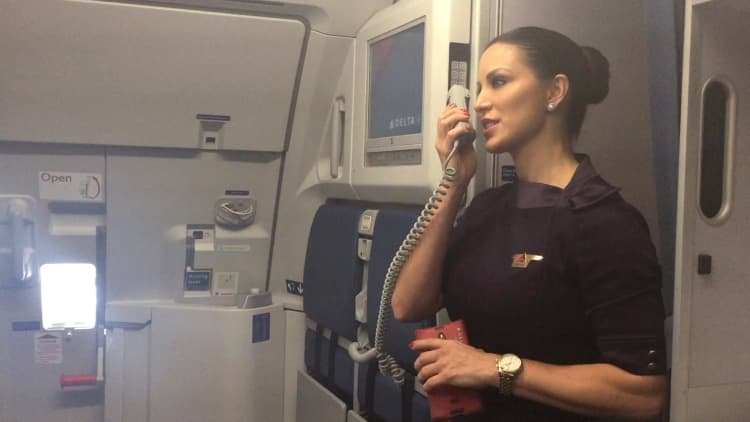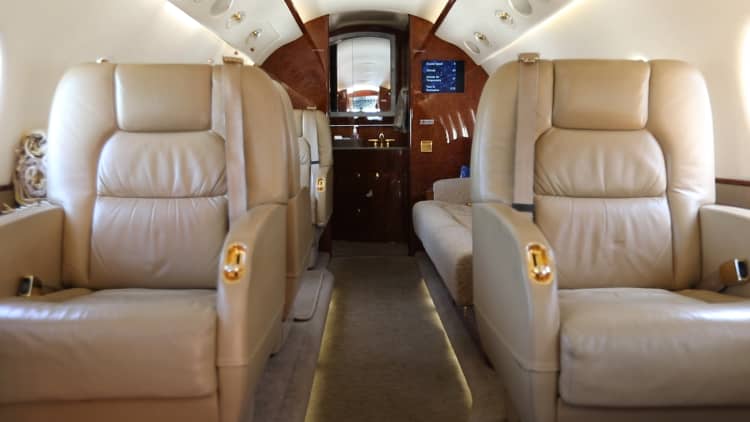Commuting to work on a private jet sounds like a perk reserved for movie stars and professional athletes. But it's just a typical Tuesday for the lawyers of Patterson and Sheridan. The Houston-based firm relies on a glossy, maple-paneled $3-million Gulfstream G200 to regularly transport its staff to meetings with clients in Silicon Valley.
And while it may seem like a luxury, the firm argues it's the most practical option.
"Given the nature of our work, it's important to be in front of our clients and be able to look, feel and touch their technology," Todd Patterson, a partner at the firm, which specializes in high-tech patents and intellectual property, tells CNBC Make It. He says the once-a-month trips allow for face-to-face meetings that provide a more hands-on, in-depth experience than a teleconference or video call.
Plus, relocating or opening a satellite office in the Bay Area — where commercial real estate is 40% more expensive, salaries are 50% higher and competition for technical talent is more intense, according to a 2017 report in the Houston Chronicle — would arguably make it difficult for the firm to hire new employees and ultimately result in Patterson and Sheridan passing some of the additional costs onto their clients.
'It kind of piqued my interest'
Patterson, himself a pilot, founded the firm in 1996 and came up with the plan to commute via jet early on, after meeting with a client on the West Coast who ran a similar service.
"I just had a fascination with airplanes," he says. "And it kind of piqued my interest."
Patterson did some digging on costs, and then took a proposal to the firm's chief financial officer, who thought it was doable. The firm, Patterson notes, has been flying for about 12 years and has had two jets.
They bought their newest one in 2016.
Although they do have a handful of secondary offices across the United States, including in San Diego and San Jose, California, where they fly frequently, the need for the plane is still prevalent, since the lawyers that "we send out there are the ones doing the heavy lifting," Patterson explains. They're more experienced with the tech that clients create.
Just another Tuesday at the office
A typical trip starts on a Tuesday around 7:30 a.m. CT at Sugar Land Regional Airport. The group departs the Houston hanger and makes their first stop in San Diego at 8:30 a.m. PT, where the lawyers working in that city deplane. The remaining passengers then head off to San Jose, where they touch down between 9:30 a.m. and 10 a.m. PT.
Wheels up to wheels down, the flight takes about four hours one way.
"We get pretty much a full day in San Diego and San Jose," Patterson says, "work all day Tuesday, work all day Wednesday, and then we try to leave San Jose after lunch on Thursday. If we leave around 2 p.m.," he adds, "we're usually back in San Diego by about 3 p.m., and then back in Houston by somewhere between 8 p.m. and 9 p.m."
The lawyers cover more ground than just San Diego and San Jose on their trips, making stops in Del Mar, Los Angeles, Santa Cruz, Santa Clara, Palo Alto and San Francisco, as well as some northern cities near wine country, Patterson says. The firm will also use the jet to visit clients in places like Minnesota, New Jersey and North Carolina on occasion.
Though some might consider a private jet to be high class, Patterson considers itto be a workhorse, logging a stunning 150,000 miles a year. "We call it 'the bus,'" he says. "It's a regularly scheduled trip and it's always full of people. It's not extravagant. It's more of a pedestrian experience."
There are no flight attendants on board and the food service consists mostly of boxed lunches.
We 'certainly don't do crazy things'
The upfront cost of the jet, which runs about $2,500 an hour to operate, and the additional expenses for food, fuel and storage while the plane is idle, can make the commute pretty pricey.
But the firm is practical about how they use it. For instance, they sometimes lease it to other companies, Patterson says, which helps offset some of the costs. And when they use it themselves, they always try to make it a full flight.
"We certainly don't do crazy things like fly one or two people long distance. The jet holds nine and we try to fly it with nine. If there's an empty seat, there's a higher cost per head."
Businesses in San Jose spend 12% more to lease office space than they pay in Houston.Kevin Greenvice president of marketing at real estate data firm RealMassive
But the biggest saver, perhaps, is that commuting allows the firm to avoid the exorbitant costs of living and working in California.
Kevin Green, vice president of marketing at real estate data firm RealMassive, points out the high prices of commercial real estate: "Businesses in San Jose spend 12% more to lease office space than what they pay in Houston," he tells CNBC Make It. A company in San Jose with 20 employees renting a 5,000-square-foot office space, "would be spending $20,000 more a year on the lease alone."
The numbers can vary based on location, building class, market conditions and other factors, Green says, but overall, rental costs in the Bay Area are significantly higher.
In addition to higher leasing rates, utilities hover around 10% higher in San Jose than in Houston, he adds, and San Jose health care costs are a whopping 24% more expensive.
California also ranks No. 11 of the most heavily taxed states in the country. A 2019 report from personal-finance website WalletHub finds that residents there have a 9.5% total tax burden, including 2.7% property taxes, 3.6% income taxes and 3.2% sales and excise taxes.
Whereas, in Texas, which ranks No. 33, residents have an 8.2% total tax burden, including 3.8% property taxes, 4.4% sales and excise taxes, and no income taxes at all.
While it "might sound absurd" to commute on an expensive jet, when you do the math and factor in actual costs, Green says, it might be the best choice. "This strategy wouldn't work for every business, but for a law firm with critical clients that require face-to-face interaction and detail-oriented meetings, it does seem like a fiscally responsible option."
There's more to consider than costs
Patterson and Sheridan isn't just saving money by flying to meetings on a private jet, though, they're saving time, a valuable commodity for lawyers who bill by the hour.
Because the firm can work on the flight, they get paid, unlike on a commercial flight, where the amount of work they can do is limited since most of it is confidential.
"We're always cognizant of client confidentiality and there are things we can't do on a commercial plane," Chad Dougherty, a partner at the firm, tells CNBC Make It. "Clients are very concerned with the privacy of their intellectual property, so there's a lot of stuff you can't open in public."
Patterson agreed: "We eliminate going through security and being subjected to flights that are delayed or canceled," he says. "With our aircraft, we're not at the airline's mercy, sitting at an airport all day, only to find out our flight's not going to happen."
'I want to figure out how to use it more'
The firm has made the jet a selling point to recruit new talent. Lawyers can have the chance to work with top tech companies in Silicon Valley while living in a more affordable part of the country.
The median home value in San Jose is more than $1 million, for example, and the median rent is a whopping $3,500. That's more than five times the median home value of $185,000 in Houston and three times the $1,500 median rent.

It's no wonder that even those making six figures at tech giants like Facebook and Twitter struggle to afford housing in California. Some residents have resorted to living in "crappy old storage rooms" that have been converted into apartments and others are sleeping in their cars.
Meanwhile, there are people like Danny Finlay, a 30-year-old account executive who lives in Dixon, California, and works in San Francisco, commuting several hours and hundreds of miles a day.
Patterson and Sheridan wanted to avoid that hassle for their employees. It turns out a private jet is the easiest way to do it.
And while some believe extreme commutes will fade as companies adopt new tech to connect remotely, the firm is holding on to tradition: "I'm hopeful we can use the jet for the foreseeable future," Patterson says. In fact, "I want to figure out how to use it even more."
Like this story? Subscribe to CNBC Make It on YouTube!
Video by Jon Fazio




